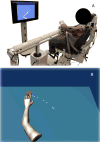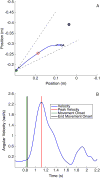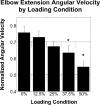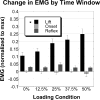Flexion synergy overshadows flexor spasticity during reaching in chronic moderate to severe hemiparetic stroke
- PMID: 28558314
- PMCID: PMC5507628
- DOI: 10.1016/j.clinph.2017.04.028
Flexion synergy overshadows flexor spasticity during reaching in chronic moderate to severe hemiparetic stroke
Abstract
Objective: Pharmaceutical intervention targets arm flexor spasticity with an often-unsuccessful goal of improving function. Flexion synergy is a related motor impairment that may be inadvertently neglected. Here, flexor spasticity and flexion synergy are disentangled to determine their contributions to reaching dysfunction.
Methods: Twenty-six individuals participated. A robotic device systematically modulated shoulder abduction loading during ballistic reaching. Elbow muscle electromyography data were partitioned into windows delineated by elbow joint velocity allowing for the separation of synergy- and spasticity-related activation.
Results: Reaching velocity decreased with abduction loading (p<0.001) such that velocity was 30% slower when lifting the arm at 50% of abduction strength compared to when arm weight was supported. Abnormal flexion synergy increased with abduction loading (p<0.001) such that normalized activation ranged from a median (interquartile range) of 0.07 (0.03-0.12) when arm weight was supported to 0.19 (0.12-0.40) when actively lifting (large effect size, d=0.59). Flexor spasticity was detected during reaching (p=0.016) but only when arm weight was supported (intermediate effect size, d=0.33).
Conclusion: Flexion synergy is the predominant contributor to reaching dysfunction while flexor spasticity appears only relevant during unnaturally occurring passively supported movement.
Significance: Interventions targeting flexion synergy should be leveraged in future stroke recovery trials.
Keywords: Arm; Biomechanical phenomena; Movement; Muscles; Neurology; Rehabilitation; Robotics; Stroke.
Copyright © 2017 International Federation of Clinical Neurophysiology. Published by Elsevier B.V. All rights reserved.
Conflict of interest statement
None of the authors have financial or other relationships that might lead to a perceived conflict of interest.
Figures





References
-
- Beer RF, Dewald JP, Dawson ML, Rymer WZ. Target-dependent differences between free and constrained arm movements in chronic hemiparesis. Exp Brain Res. 2004;156:458–70. - PubMed
-
- Beer RF, Given JD, Dewald JP. Task-dependent weakness at the elbow in patients with hemiparesis. Arch Phys Med Rehabil. 1999;80:766–72. - PubMed
-
- Bensmail D, Robertson JV, Fermanian C, Roby-Brami A. Botulinum toxin to treat upper-limb spasticity in hemiparetic patients: analysis of function and kinematics of reaching movements. Neurorehabil Neural Repair. 2010;24:273–81. - PubMed
-
- Bohannon RW, Smith MB. Interrater reliability of a modified Ashworth scale of muscle spasticity. Phys Ther. 1987;67:206–7. - PubMed
Publication types
MeSH terms
Grants and funding
LinkOut - more resources
Full Text Sources
Other Literature Sources
Medical

